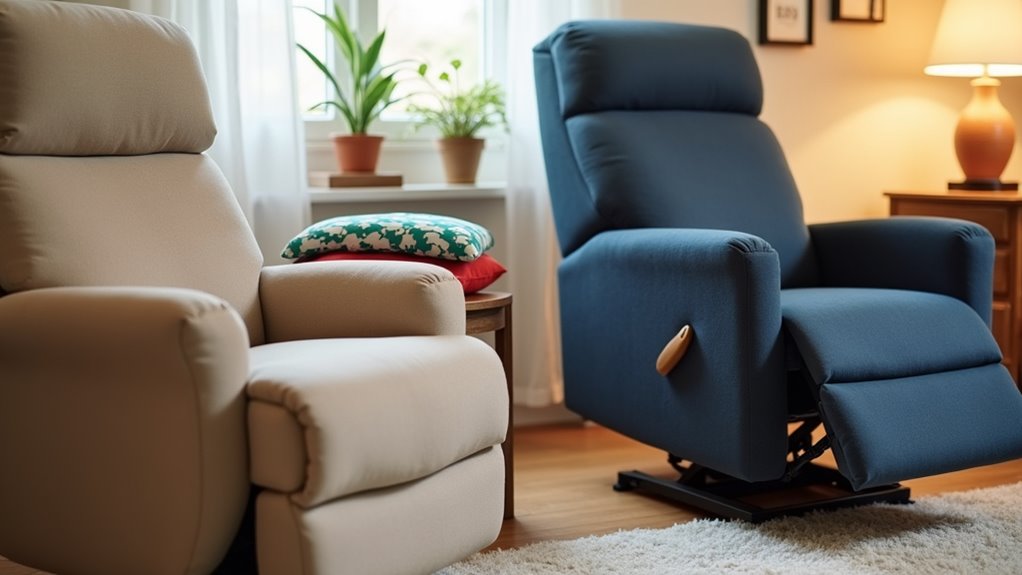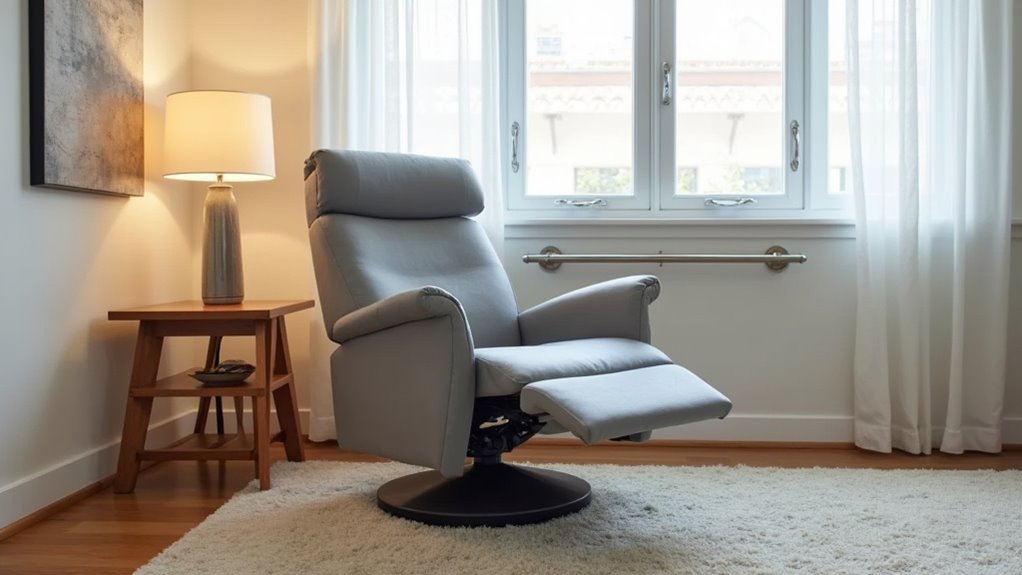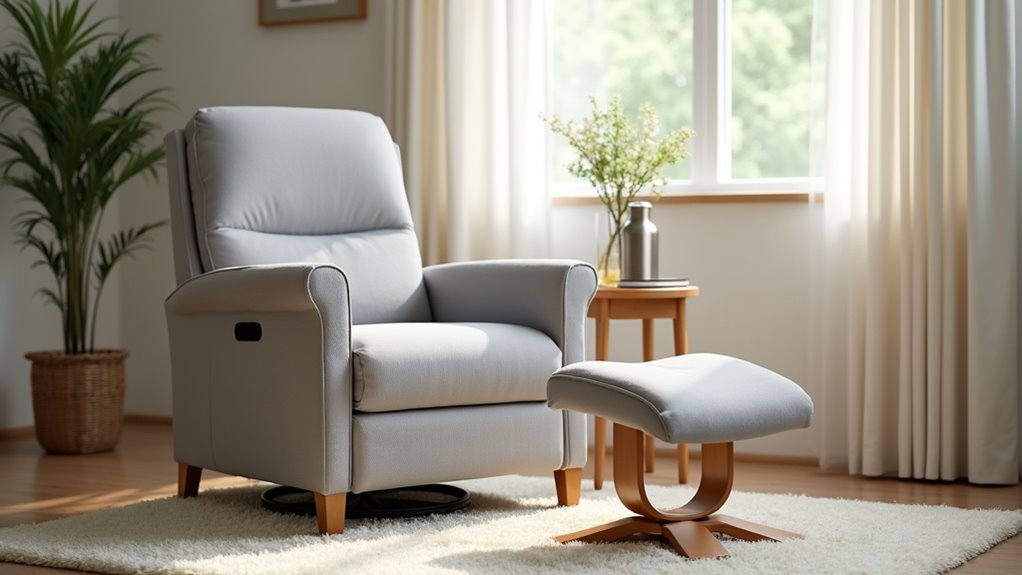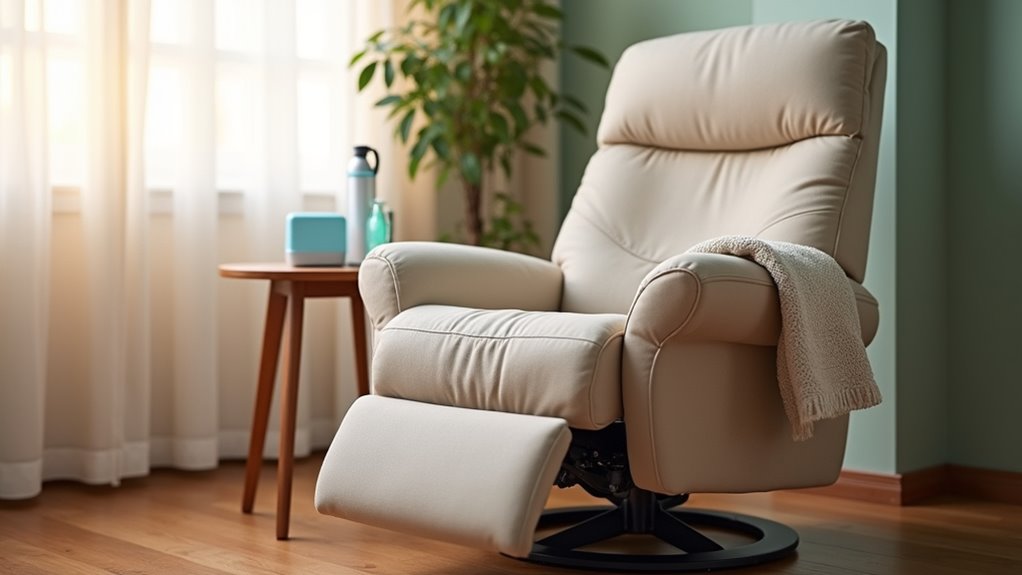Do You Need a Special Chair After Hip Replacement? Health Tips
This post contains affiliate links. As an Amazon Associate, we earn from qualifying purchases.
After a hip replacement, using a special chair is important for your recovery. Opt for chairs that elevate your hips above your knees—ideally between 20 to 26 inches high. Firm, straight-backed chairs or hip chairs are excellent choices for easy sitting and standing. It’s advisable to utilize these chairs for about 4 to 6 weeks while you heal. Keeping your living space organized is also crucial to prevent tripping hazards. For those interested in more detailed information and additional tips, keep reading.
Essential Facts in 30 Seconds
- Specialized hip chairs help maintain proper hip alignment and reduce strain during recovery.
- Ideal seat height for chairs is between 20 to 27 inches to keep hips higher than knees.
- Firm, straight-backed chairs promote good posture; zero gravity chairs improve circulation and lessen pressure on hips.
- Armrests assist with safe sitting and standing, reducing dislocation risk during healing.
- Use specialized seating for 4 to 6 weeks post-surgery, transitioning to regular chairs as healing progresses.
Importance of Chair Height for Hip Safety
After hip replacement surgery, the right chair height is very important. Your hips should sit higher than your knees. This helps avoid strain on your healing joints. Aim for a seat height between 20 to 26 inches.
A chair that’s too low can force your legs to tuck under. That isn’t safe for your hips. Hip chairs are specifically designed to promote a higher seat height, making them ideal for recovery. Selecting an ergonomic chair with adjustable height features can further enhance comfort and support during your recovery. Proper chair height also helps maintain a 90-degree angle at your knees, which is essential for reducing strain. Additionally, ensure that the chair provides adequate lumbar support to promote a healthy sitting posture.
Use firm seat materials for better support. You can add cushions or risers to your chair for extra height. Just make sure they’re stable. Wobbly chairs can be dangerous.
Armrests are helpful too. They make sitting and standing easier, just like having a friend help you.
Keep your hips happy and safe. This way, your recovery will go smoothly. No need for any tricky moves!
Recommended Chair Types for Post-Surgery Recovery

Finding the right chair for post-surgery recovery is important. A good chair can help you feel comfortable and safe. It can even speed up your healing.
Here are some chair types to consider:
- Zero Gravity Chairs: These chairs support your body well. They keep pressure off your hips and reduce swelling, while also promoting better blood circulation to aid in recovery.
- Firm, Straight-Backed Chairs: These chairs give solid support. They help you maintain good posture and keep your hips safe.
- Hip Chairs: These chairs have higher seats. They make it easier to sit down and stand up without bending too much.
Choosing the right chair can make recovery easier. Comfort and safety should be your top priorities.
Duration for Using Specialized Seating
After settling into the right chair, think about how long to use specialized seating for recovery. You’ll typically use this special chair for about 4 to 6 weeks after your hip replacement. It helps keep your hips safe and reduces the chance of dislocation. During your recovery, it’s essential to monitor for worrisome symptoms to ensure everything is progressing well.
Here’s a simple overview of what to expect during recovery:
| Recovery Phase | Seating Duration |
|---|---|
| Initial Phase | 4 to 6 weeks |
| Change Phase | 6 weeks to 3 months |
| Long-Term Tips | As needed, focus on comfort |
As you heal, you can slowly return to regular seating. Always prioritize safety and comfort. Keep in touch with your therapist for the best advice. You’ve got this!
Essential Home Modifications and Equipment

After a hip replacement, make smart changes at home.
Adjust chair heights. This helps with sitting and standing. Proper chair height can enhance comfort and productivity during recovery. Ensuring proper height can also help maintain ideal knee angle for optimal posture. Grab important tools like shower chairs and grab bars for the bathroom. These items make daily tasks easier.
Clear walkways and remove clutter. This prevents trips and falls. Keep frequently used items within reach. Use a reacher or grabber tool for hard-to-reach spots.
Consider using a raised toilet seat. It adds comfort and safety. Non-slip mats in the bathroom can help too. Additionally, proper sitting posture is crucial to ensure comfort and support during recovery. Making adjustments to your chair height can significantly improve your overall sitting experience.
Chair Height Adjustments
Chair height adjustments after hip replacement surgery matter a lot. A good fit helps you recover better!
A comfy chair puts less stress on your joints. The right height keeps you safe from falls. You’ll feel more in control when sitting and standing. Proper sitting posture is vital for overall health and comfort. Adjusting the chair height to ensure your knees are lower than your hips can help prevent strain on back and legs.
Aim for a chair height between 20 to 27 inches. Your knees should be lower than your hips. If your favorite chair is too low, use cushions or stable platforms.
Look for soft seat materials for added comfort! Keeping your hips above your knees prevents bending too much. Regularly checking your overall posture will also help you maintain comfort and stability while sitting.
Just a few tweaks, and you’ll feel like a champ!
Recommended Equipment Essentials
Getting the right equipment is key for a smooth recovery after hip replacement surgery. Start with mobility aids like walkers or canes. These tools help you stay steady as you heal.
Swap slippery slippers for nonslip shoes. They’ll keep you safe on your feet.
Dressing aids make a big difference too. A sock aid helps you put on socks without bending too much. Long-handled shoehorns let you slide into shoes without straining your hip.
Don’t forget about hip kits. These kits include handy tools like dressing sticks and elastic shoelaces. They make getting dressed easy.
Focus on your recovery. Every little step counts! You’ve got this!
Safety Modifications at Home
Your mobility aids are ready. That’s great!
Now, let’s make your home safe for recovery. Fall prevention is very important. Here are some easy tips to help:
- Clear away clutter. Keep walkways wide for easy movement.
- Secure loose rugs. Use non-slip mats in wet areas.
- Install grab bars near the toilet and shower for extra support. Regularly inspect loose components to ensure safety and stability in your home.
These changes can make a big difference. Correct sitting posture is also essential for your recovery as it prevents discomfort and promotes healing. Remember to choose a chair with lumbar support to help maintain proper spinal alignment. Stay safe and recover well!
Safety Tips for Sitting and Standing

Sitting and standing after a hip replacement can be tricky. Safety is important during these movements. Use firm chairs with armrests. They help you sit down and stand up safely.
When sitting, back up to the chair. Lower yourself gently and feel for the armrests. Keep your knees lower than your hips. Avoid low or soft chairs. Additionally, ensure that the chair is at the correct chair height adjustment to promote better blood circulation and minimize discomfort. A chair with lumbar support cushions can also enhance your sitting experience by promoting good posture. Adjusting the backrest support can further ensure that your spine is aligned properly, reducing strain during prolonged sitting.
Here’s a quick reference table:
| Sitting Posture | Standing Techniques |
|---|---|
| Use firm, stable chairs | Push up using armrests |
| Keep knees lower than hips | Keep operated leg straight |
| Avoid low, soft chairs | Take slow, deliberate steps |
Follow these tips to stay safe and comfortable.
Enhancing Comfort and Recovery Quality

Recovering from a hip replacement can be tough, but comfort during this time is important. A comfortable chair can help a lot. Here are some tips for choosing the right chair:
- Select a chair with a firm seat and a straight back. This helps with good posture.
- Choose a chair with a seat height of 26-27 inches. This reduces strain on your hips.
- Look for armrests. They can help you stand up safely. A chair that allows for proper adjustments enhances overall comfort and support.
A well-designed chair makes sitting and standing easier. It keeps your hips safe and comfortable. Additionally, ensure that your chair supports proper sitting posture, as this can significantly enhance your overall recovery experience.
Remember, comfort is just as important as healing! You can add footrests or cushions for extra comfort.
And if you spill something, just clean it up quickly. Keep it fun, and you’ll recover smoothly!
Frequently Asked Questions
Can I Use a Regular Dining Chair After Surgery?
Using a regular dining chair after surgery is not the best choice. Choose chairs with armrests for support. Make sure the chair height keeps your hips above your knees. This position helps you move safely during recovery. Comfort matters too. Look for chairs with good padding. Avoid low or soft chairs. They make getting up difficult. Focus on your safety and comfort as you heal.
What if I Don’T Have a High-Backed Chair?
Don’t worry if you lack a high-backed chair. Firm dining chairs can be a great substitute. They provide good support. To increase comfort, add cushions for extra height. It’s also important to have armrests for safety. These simple changes can help during your recovery. Stay comfortable and safe while you heal.
Is It Safe to Sit on a Couch?
Sitting on a couch can be safe. Choose a couch that is firm and a bit higher off the ground. Use pillows for extra support. Good posture is key. Sit up straight to avoid hurting your back and hips. Comfort is important too. Stay relaxed while sitting to prevent strain. Always pay attention to how your body feels. Enjoy your time on the couch!
How Can I Adjust My Existing Chair’s Height?
Adjusting your chair height can improve comfort and support. You can use cushions, risers, or blocks to raise your chair. These methods help keep your knees lower than your hips. This position is good for your body, especially during recovery.
Cushions can add height easily. Place them on the seat to create a better fit. Risers can lift the entire chair. They are stable and safe to use. Blocks work well too. Just make sure they are strong enough to hold your chair.
Finding the right height is important. You should feel comfortable when sitting. Your feet should rest flat on the floor. Your back should be straight and supported. Adjusting your chair makes a big difference in how you feel.
Can I Use My Recliner if It Has Support?
Using your recliner is fine as long as it gives good support. It should help you stay safe while you heal from hip surgery. Avoid bending too much. Sit up straight to lower the chance of dislocation. This helps your recovery. A good recliner can make a difference. Keep your body in a safe position. This will help you heal better and faster. Always listen to your doctor’s advice about your recovery.
Conclusion
Choosing the right chair after hip replacement is key for comfort and safety. Look for a chair that is the right height for you. A chair that is too low or too high can make sitting and standing difficult. Make simple changes in your home to help with this.
Think of your chair as a special spot for healing. Keep it cozy and easy to get in and out of. Add cushions if you need more height. Use armrests to help push yourself up.
A good chair helps you relax and recover faster. So, find that perfect seat. Get comfortable and focus on your healing journey. You can do this!
